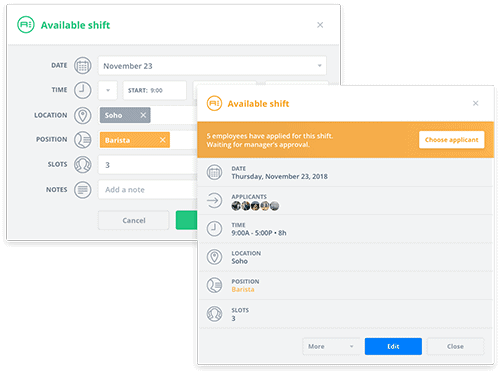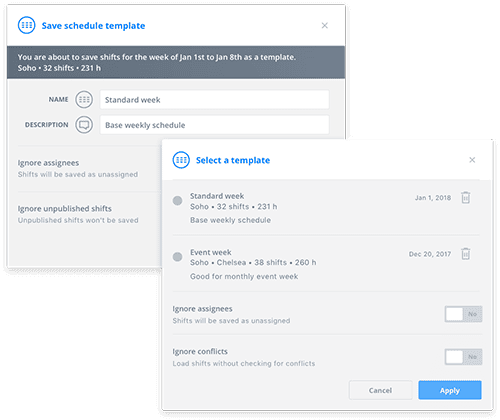15 Ways To Deal with Employees Who Are Late for Work
Learn how to deal with employees who are repeatedly late for work so their tardi...

In today’s rapidly changing business world, types of work schedules are as varied as the companies that adopt them.
Because of the diversity in work schedule types, it’s easy to become confused — both with the terms used to describe the schedule and with the hours each one indicates. But the management experts at Sling are here to help.
In this article, we’ll explain some of the most common types of work schedules so you can find the one that best suits your business and your employees.

Before we begin, it’s important to understand that many of these work schedule types are similar to one another. Each term may describe a slight difference in days or hours worked.
Because of these similarities and differences, you can combine individual work schedule types to create your own unique plan. For example, you could combine terms to develop a fixed part-time seasonal morning shift or a full-time rotating on-call shift.
It all depends on the needs of your business and the availability of your employees.
A standard business schedule is one where employees work set days (usually Monday through Friday) and set hours (usually 9 a.m. to 5 p.m.). This is often referred to as a “9-to-5 work schedule.”
The standard work schedule is common enough that most employees will already be used to working those regular hours. Employees also like the standard schedule because it’s easy to plan for — they know they will be working from 8 a.m. to 5 p.m. Monday through Friday.
From an employer’s perspective, this type of schedule is one of the easiest to fit into a 24-hour day. And since most scheduling apps are built around this work day, you don’t have to force your software to fit another type of work schedule.
Fixed is similar to the standard work schedule — set days and set hours — but can apply to alternative work times, such as Tuesday through Saturday from 10 a.m. to 6 p.m.
For employers, a fixed schedule allows for long-term planning and makes it easier to calculate labor costs. It also makes creating the schedule much simpler because the work hours are set from day to day, week to week, and month to month.
With a fixed schedule, you don’t have to change your regular template every time you make a new work schedule.

A full-time work schedule type indicates that an employee will work 37-40 hours per week. They may work five 8-hour days, four 10-hour days, or six 6.5-hour days. The days worked don’t matter, just the total amount of hours.
A full-time type of work schedule provides employers and employees with stability and predictability. But when you build a team where all employees work full time, it can be difficult and costly to find someone to work overtime.
With all full-time employees, you may encounter a dilemma in which you need a few hours of extra work but can’t find any volunteers or don’t want to pay overtime and the workload doesn’t warrant hiring a new employee.
A part-time work schedule is one in which an employee works fewer than full-time hours. Because of the reduced hours, employees may only work two or three days per week and may not work the regular eight hours per day.
This kind of schedule works well for certain types of businesses (e.g., restaurants and coffee shops) but can create extra headaches for other types of businesses (e.g., offices and call centers).
For managers, a team composed of only part-time employees means that you’ll have to deal with a larger pool of individuals when creating your schedule. That’s not always a bad thing, but it can make sorting through availability a major undertaking.
Another of the more common work schedule types, shift work is usually reserved for businesses that operate more than 10 hours in a single day.
If a business stays open around the clock (24 hours), they will usually set up a first shift (e.g., 7 a.m. to 3 p.m.), a second shift (e.g., 3 p.m. to 11 p.m.), and a night, or third, shift (e.g., 11 p.m. to 7 a.m.).
Depending on your business, shift work means your employees will be required to work what might be considered irregular hours. Early or late shifts are ideal for those employees going to school or taking care of their family or sick relatives, but most people would rather work a more “normal” 9-to-5 schedule.

A freelance schedule is relatively new amongst work schedule types. Essentially, a freelancer can work whenever they choose as long as the work gets done by a set deadline.
For an employer, incorporating a freelance type of work schedule means that you relinquish a great deal of control over when your “employee” works. However, if you find a person you can trust to get the job done correctly and on-time, a freelance schedule makes a good deal of sense.
But if your freelancer isn’t focused or you don’t want to give up control of when your employees work, this type of schedule may not be right for you.
An unpredictable work schedule changes from week to week in an erratic manner (i.e., not following a regular pattern).
Many states have laws regulating and even prohibiting unpredictable work schedule types, and unpredictable work schedules are difficult for both employees and employers.
For employees, it’s almost impossible to plan activities outside of work (e.g., doctor’s appointments, childcare, etc.) because they have no idea when they will work next.
For employers, an unpredictable type of work schedule requires recreating your template from scratch every time.
A seasonal work schedule is in effect for only a few months out of the year. Typical seasonal work schedule types include holiday (November through December) and summer (June, July, and August).
For those businesses that are only open for a few months out of the year or need to hire extra personnel during the holidays, a seasonal schedule is ideal. But hiring seasonal employees means you’ll have to fill your already-busy schedule with interviewing, onboarding, and training.
On a flex schedule, you require your employees to work a certain amount of core hours (e.g., 11 a.m. to 2 p.m.) in a certain place (e.g., the office). The employee can then work the remainder of their hours when and where they want.
A flex work schedule is a wonderful benefit you can offer your employees. But it can make organizing team meetings and other group functions extremely difficult because your employees are coming and going as they please outside of the core hours.
If you encounter an emergency and need to rally the troops, you may have to send out emails or texts rather than meeting face-to-face.

An alternate work schedule is a broad term used to refer to any work schedule type that is different from the schedule used by others in your business. Alternate schedules are usually implemented to accommodate employee needs (e.g., pregnancy, medical requirements, family issues).
An alternate work schedule means that you have to hire a new employee to take the place of (or make up for) the hours the original employee vacated. Alternate work schedules are usually temporary but can become regular if the issues that necessitated the new hire persist.
A compressed work schedule type is one in which employees work the same amount of hours in fewer days when compared to the standard “9-to-5” model. An example might be 7 a.m. to 5 p.m. Monday through Thursday.
A compressed type of work schedule provides fixed work hours, which make it easier to plan and predict labor costs. Compressed schedules also give employees a better work/life balance because they know they will have an extra day off every week to take care of personal issues.
A rotating work schedule type is usually applied to shift work. It is set up so that employees work first shift one week, second shift the next week, and third shift the following week. You can also rotate shifts from day to day.
The downside of a rotating type of work schedule is that employees suffer from decreased engagement because their work hours never stabilize.
For certain professions (e.g., nursing, police officers, fire fighters), a rotating work schedule is a necessary part of the job, but for other professions, a rotating type of work schedule can cause more problems than it attempts to solve.
A split work schedule means that an employee may work a few hours at one point during the day, have several hours off, and then work the rest of their hours during another part of the day.
For example, an employee might work 7 a.m. to 9 a.m., be off for five hours, and then finish working from 2 p.m. to 5 p.m.
A split type of work schedule can be unduly difficult for your employees. Local, state, and federal laws often dictate the minimum amount of time between two split shifts, which means your employee will have to leave your business and then return several hours later.
For some employees, this may allow them to pick up children from school or take care of personal issues. But it also means that they have to deal with two separate commutes.
That alone can put undue stress on your employee and make a split shift less than ideal.

An on-call schedule is one where the employee is available to work any time, day or night, as the employer demands. On-call work schedules typically rotate between employees so that one person doesn’t have to work all the time.
Most employers use an on-call type of work schedule to plan for emergencies or to prepare for no call, no show employees.
Physicians often work one on-call day or weekend per month in case an emergency arises. For other businesses, you might set up an on-call schedule in case the regularly scheduled employee gets sick or can’t make it in for some reason.
An overtime schedule means working more than the standard full-time hours each week. Wages for overtime work are usually higher than that for hours fewer than 40 (e.g., time-and-a-half or double time).
You may find that overtime is necessary during big projects or during certain times of the year. But employers avoid overtime as much as possible because it gets very expensive very quickly.
In some cases, employers will ask one or two employees to work a few hours of overtime here and there in order to keep labor costs low while still covering the hours necessary to get the job done.
In this type of work schedule, the employee has a set of responsibilities and tasks that they must complete, but you — the employer — don’t dictate the hours they must work.
So, for example, if the employee can finish their assignments in less than a full 40-hour work week, they can take the rest of the week off. Similarly, with no set schedule, they could opt to work early in the morning or late at night.
No set schedule is similar to a freelance schedule in that the employee decides when to work. No set schedule is different from a freelance schedule in that the employee usually reports to your office to perform their work.
For employees, having no set schedule can motivate them to get their work done early in the week in order to have an extra day off. But it takes a focused and driven type of employee to make this schedule work because there is so much freedom involved.
For employers, this type of work schedule can provide the work/life balance many employees are looking for and result in a much happier team. The downside for employers is that no set schedule is incredibly difficult to track and ensure that you’re getting your money’s worth for the work done.
The 2-2-3 schedule (a.k.a. the Panama schedule) is a complex system for maintaining 24-hour, seven-day-a-week employee coverage that balances out long employee shifts by giving all employees regular two- or three-day periods of time off and equitably distributing night shifts.
Here’s how it works:
Week One: Team A works two 12-hour day shifts followed by two days off, followed by three more 12-hour day shifts.
Week Two: Team A starts the week with two days off, followed by two day shifts, and then three more days off.
Week Three: Team A works two 12-hour night shifts followed by two nights off, followed by three more 12-hour night shifts.
Week Four: Team A starts the week with two nights off, followed by two night shifts, and then three more nights off.
To achieve full coverage, your business would rotate three other teams (or individuals) through the same pattern but offset by one week (e.g., Team A is on week one, Team B is on week two, Team C is on week three, and Team D is on week four).

The Pitman is a common variation of the 2-2-3 schedule that some businesses use to maintain round-the-clock operational status.
It’s about 98% the same as the 2-2-3 type of work schedule with one big difference: the teams or individuals don’t swap day and night shifts.
The Pitman runs on a two-week cycle that looks like this:
Week One:
Week Two:
After week two, the cycle starts over so that Teams A and C always work the day shifts and Teams B and D always work the night shifts.
For more information on the pros and cons of the Pitman schedule, check out this article from the Sling blog: Pitman Schedule: How it Works, Pros, Cons & Best Practices.
The DuPont schedule is another variation of the 2-2-3 schedule wherein work hours revolve around 12-hour shifts instead of eight-hour shifts.
Within the DuPont schedule itself, teams rotate through a 28-day cycle with the following characteristics:
Week One: Team A works four (12-hour) day shifts followed by three days off.
Week Two: Team A works three day shifts followed by one day off and then three night shifts.
Week Three: Team A gets three nights off followed by four day shifts
Week Four: Team A gets seven consecutive days and nights off
Like the 2-2-3 schedule, you can achieve full coverage by rotating three other teams through the same four weeks but offset from each other by one week (e.g., Team A is on week one, Team B is on week two, Team C is on week three, and Team D is on week four).
The 9/80 type of work schedule has employees working a total of eight nine-hour days, one eight-hour day, and one day off spread over a two-workweek period so they amass 80 hours of nine work days (not counting Saturdays and Sundays).
That can be hard to visualize, so here’s a breakdown of how it all works:
Monday: 7-12 and 1-5 with an unpaid lunch break in-between (9 hours total)
Tuesday: Same
Wednesday: Same
Thursday: Same (for a total of 36 hours)
Friday: 8-12 (first week ends) + 1-5 (second week starts)
Saturday: Off
Sunday: Off
Monday: 7-12 and 1-5 with an unpaid lunch break in between (9 hours total)
Tuesday: Same
Wednesday: Same
Thursday: Same (for a total of 40 hours including the four hours worked the previous Friday)
Friday: Off
Saturday: Off
Sunday: Off
For more information about the benefits and challenges of this type of schedule, take a few minutes to read this article from the Sling blog: 9/80 Work Schedule: What It Is, Its Benefits And Challenges, And How To Get Started.

Regardless of the myriad work schedule types you have to choose from, the best way to stay organized when creating your employee work plan is to use a specialized suite of software tools like Sling.

S
Sling makes quick work of even the most complicated work schedule type thanks to its flexibility and built-in artificial intelligence. What once took hours now takes mere minutes thanks to:

Then, once the schedule is set, you can harness the power of Sling’s other features — onboard time clock with geofencing, labor cost tracking and analysis, group communications, newsfeed, and task list — to simplify and streamline the time it takes to organize and manage your workforce.
For more free resources to help you manage your business better, organize and schedule your team, and track and calculate labor costs, visit GetSling.com today.
This content is for informational purposes and is not intended as legal, tax, HR, or any other professional advice. Please contact an attorney or other professional for specific advice.
See Here For Last Updated Dates: Link
Schedule faster, communicate better, get things done.